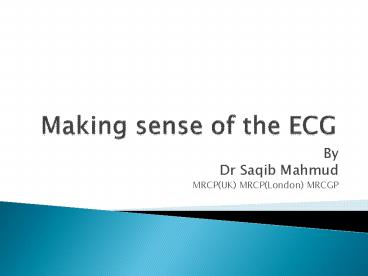Making sense of the ECG - PowerPoint PPT Presentation
1 / 42
Title:
Making sense of the ECG
Description:
... diltiazem etc Consider repeating for interval change Compare with previous ECG if ... tachycardia Hypothermia Hypothyroidism B-blockade Raised ICP ... – PowerPoint PPT presentation
Number of Views:234
Avg rating:3.0/5.0
Title: Making sense of the ECG
1
Making sense of the ECG
- By
- Dr Saqib Mahmud
- MRCP(UK) MRCP(London) MRCGP
2
Systematic approach to ECG
- Rate normal, tachycardia or bradycardia
- Rhythm sinus or irregular
- P waves present (II V1 best leads to assess)
- PR interval
- QRS complexes axis- widened QRS, Q waves,
buddle branch block, voltage criteria for LVH - ST segments isoelectric, depression or
elevation - T waves N, peaked or inverted
3
Clinical correlation of ECG
- What was the indication?
- age
- Symptoms-CP, palpitations, sob, syncope,
dizziness - Haemodynamically stable?
- Clinical signs- HF, poor peripheral perfusion
- Pre-morbid Hx-HTN, IHD, DM, CKD
- Medications- b-blockers, diltiazem etc
- Consider repeating for interval change
- Compare with previous ECG if available
4
Criteria / recap
- LVH sum of S in V1 R in V5 or V6 gt35
- RBBB tall R in V1, QRS gt0.12sec, RsR pattern
- LBBB - QS-V1,V2, QRSgt0.12
- Axis - Axis leads-IIII or IaVF, Normal axis-
double thumbs up(IIII), RAD? I ve, III ve,
LAD? I ve, III ve - Inferior leads-------------?II, III, aVF
- Antero-septal leads------?V1,V2,V3V4
- Antero-lateral leads------?I,aVL,V5,V6
- Heart rate calculation-(rhythm regular) count the
no of large squares b/w 2 consecutive QRS
divide into 300.HR300/? - Irregular count no QRS in 30 large squares X 10
5
Normal
- RBBB
- LBBB
6
(No Transcript)
7
(No Transcript)
8
(No Transcript)
9
axis
- Thumbs up!
- Normal axis
10
- RAD
- LAD
11
Bradycardia - HRlt60bpm(causes)
- Sinus bradycardia
- Sick sinus syndrome
- 2nd or 3rd degree/CHB
- Escape rhythms- form of safety net to maintain
heart beat if impulse generation fails or blocked
- Negatively chronotropic drugs
beta-blockers(dont forget eye drops!), Ca
antagonist diltiazem, verapamil, digoxin
12
Symptomatic bradycardia can present with
- Dizziness
- Syncope
- Recurrent falls in elderly
- Fatigue
- Breathlessness
- CP
- Palpitations
- O/E-look for hypotension, signs of HF poor
perfusion - Relevant Investigations UEs , TFTs
13
(No Transcript)
14
Tachycardia-HRgt100bpm
- Narrow complex (lt3 small squares)
- Broad complex (gt3 small squares)
- Narrow complex tachycardias always
supraventricular in origin - Narrow complex tachycardias
- Sinus tachycardia
- Atrial fibrillation
- Atrial flutter
- AV nodal re-entrant tachycardia
15
(No Transcript)
16
Broad complex tachycardia
- Occurs if normal electrical impulses are
abnormally or aberrantly conducted to the
ventricles causing delay in ventricular
activation widening of QRS complex - VT
- Torsades de pointes
- Accelerated idioventricular rhythm
- SVT with aberrant conduction
17
VT
18
Tosade de pointes
19
SVT with aberrant conduction
20
Assessment of tachycardia
- Tachycardia causing hemodynamic disturbance
requires urgent Rx - Evidence of hemodynamic disturbance
- Hypotension
- Cardiac failure
- Poor peripheral perfusion
- Investigations
- FBC
- UEs
- TFTs
- BNP
21
Possible causes
- Hypothermia
- Hypothyroidism
- B-blockade
- Raised ICP
- Obstructive jaundice
- Uraemia
- Increased vagal tone
- Ischemia
- Structural SA node disease
- Thyrotoxicosis
- Any cause of adrenergic stimulation including
pain - Hypovolaemia
- Anaemia
- Pregnancy
- Fever
- Myocarditis
- drugstheophylines,salbutamol, vasodilator
antihypertensives
- Sinus bradycardia
- Sinus tachycardia
22
Heart rhythm dysrhythmias
- Is it regular or irregular?
- Regular rhythms
- Sinus rhythm- P waves precedes every QRS complex
with consistent PR interval - Nodal or junctional rhythm- no P wave preceding
QRS complex but narrow regular complexes - Atrial flutter-saw tooth appearance, rapid
regular with a rate about 150bpm(21 block) - SVT, AVNRT-if high rate 150-220bpm
23
(No Transcript)
24
Junctional or nodal rhythm
25
AVNRT
26
Irregular rhythms
- Sinus arrhythmia-P wave precedes QRS with
constant PR interval but irregular
27
Atrial fibrillation- no P waves preceding each
QRS with an irregular rate
28
2nd degree HB(Mobitz type 1/ wenckebachs)-
progressive lengthening of PR interval ending
with a dropped beat followed by short PR interval
29
(No Transcript)
30
2nd degree HB/Mobitz type 2-P waves followed by
QRS, fixed PR interval with occasional
non-conducted or dropped beat
31
3rd degree/ CHB
32
(No Transcript)
33
ST segment elevation
34
Ventricular ectopic-QRS broad bizarre,gt3 small
squares, T opposite to QRS
35
(No Transcript)
36
(No Transcript)
37
(No Transcript)
38
(No Transcript)
39
(No Transcript)
40
Tented t waves
41
VF
42
The end
- Thank you

